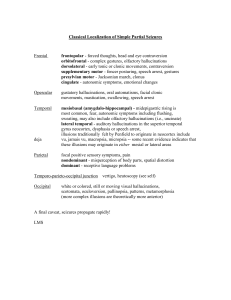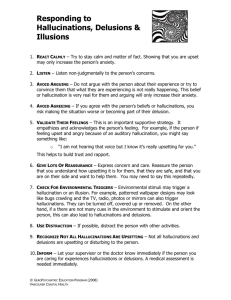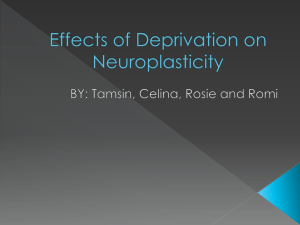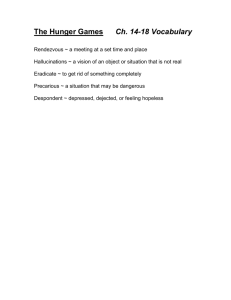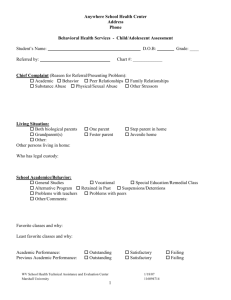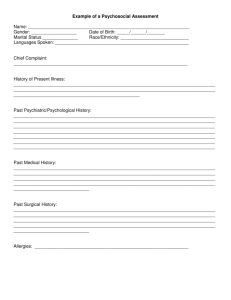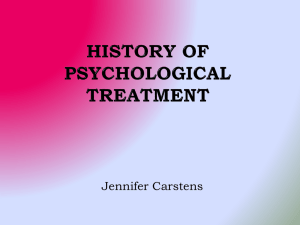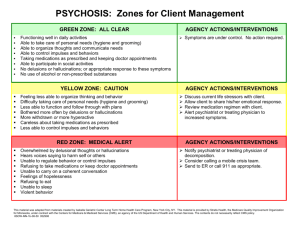Visual hallucinations
advertisement
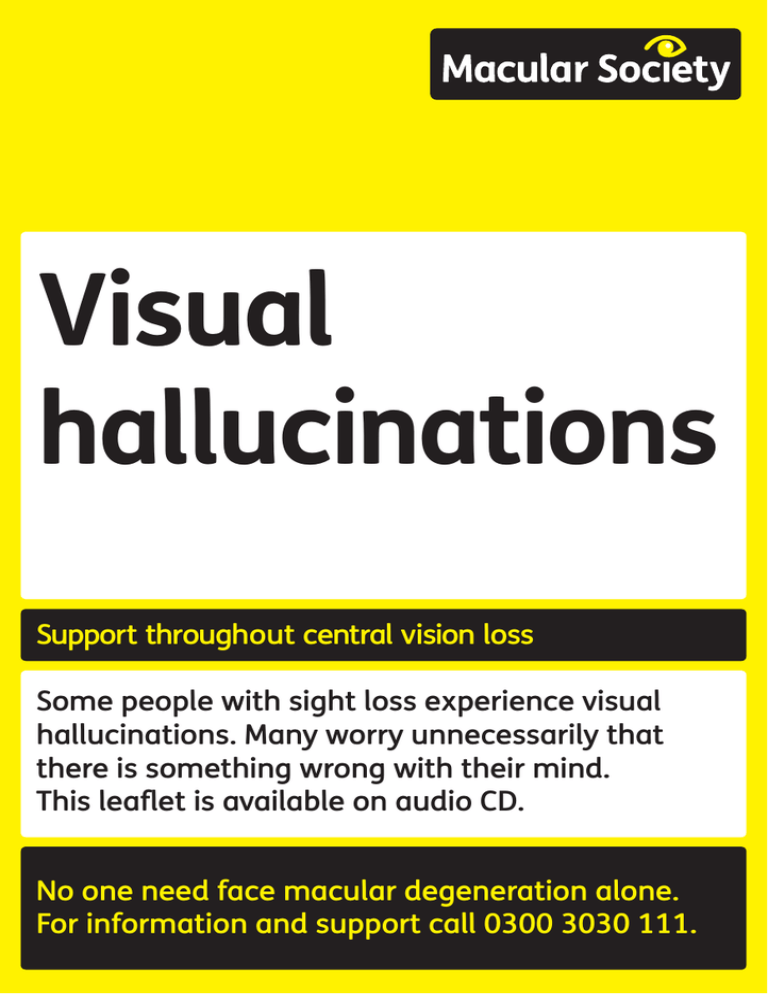
Visual hallucinations Support throughout central vision loss Some people with sight loss experience visual hallucinations. Many worry unnecessarily that there is something wrong with their mind. This leaflet is available on audio CD. No one need face macular degeneration alone. For information and support call 0300 3030 111. Macular Society In this leaflet we look at why people with sight loss sometimes experience visual hallucinations and at possible ways to cope with them. Given the right circumstances, we can all see things that are not actually there. For some of us, the visions, more correctly called hallucinations, come naturally while falling asleep or when waking up – a sort of waking dream. Hallucinations can also occur because of sight loss, particularly through macular 2 degeneration. It is important to understand that the hallucinations are a natural experience and not a sign of mental illness. When hallucinations happen as a result of sight loss they are known as Charles Bonnet Syndrome; after an 18th century Swiss scientist and philosopher who first described the condition. Up to half of all people with macular degeneration are thought to experience Charles Bonnet hallucinations at Visual hallucinations some time. Visual hallucinations are more likely to occur if both eyes are affected by sight loss. The hallucinations often start after a decline in vision. What is a visual hallucination? We can all conjure up pictures in our mind’s eye, for example, a picture of a tomato. We can rotate the imaginary tomato, examine its redness and the smooth texture of its skin. However, the image is vague, entirely under our control and we understand it is part of our imagination. This sort of internal picture, correctly termed a visual image, is not a hallucination. A visual hallucination is the same experience as really seeing something, the only difference being that the ‘something’ is not actually there. Visual hallucinations appear to exist in the real world rather than in the mind’s eye. They come and go unannounced and can last for just a few seconds or as long as a day or more. 3 Macular Society The syndrome itself can last from days to years. For most people the hallucinations do eventually disappear. landscaped gardens or vistas, animals, people, or processions of miniature costumed figures wearing hats. What do these hallucinations look like? Ironically, the hallucinations are often seen in more vivid detail than real life. Charles Bonnet hallucinations can be simple unformed flashes of light, colours or shapes. However, many people see more elaborate forms such as geometrical grids and lattices. Some people report seeing disembodied faces with staring eyes, 4 Some people enjoy their hallucinations. However, they are more often an unwanted distraction and can be rather frightening. When they cause rooms or buildings to seem altered, it can be disorientating when trying to get around. Visual hallucinations Can you stop the hallucinations? The Macular Society has sponsored research by Dr Dominic ffytche of the Institute of Psychiatry in London into non-drug treatments for visual hallucinations. Dr ffytche recommends using eye movements to lessen the impact and length of hallucinations. Eye movements activate visual parts of the brain in people with macular disease – even if they have little remaining vision. These movements may stop certain types of hallucinations, particularly the grids, checkerboards, lattices and colours. Try these exercises below when you have the hallucinations. They may help them disappear. • Imagine two points about a metre (3ft) apart on a wall in front of you. Stand about a metre and a half away and look from one point to the other once every second or faster for 15–30 seconds, followed by a break of a few 5 Macular Society seconds. Hold your eyes open during these movements. • If your hallucinations continue, try repeating this exercise. If the hallucinations are still there after four or five attempts, the technique is unlikely to work. You may however want to try again on another occasion or for a different type of hallucination. • Shut your eyes or look away from the image. • Switch on the room lights. • Simply get up and do something else. 6 Visual hallucinations seeing. There is an area specialised for movement, an area for colour, several for faces, one for landscapes and many others. the visual pathways, what was once a flood becomes a trickle. This leaves the visual areas of the brain with little to do. Scanning studies have revealed what happens in the brains of people while they hallucinate. These studies help explain some of the features of Charles Bonnet hallucinations. The idle visual brain cells, waiting for an appropriate trigger, begin to fire spontaneously. If this happens in the colour area, people experience hallucinations of colour; if in the object area, they see objects and so on. With our eyes open, the visual brain expects to receive and process a flood of complex electrical signals. In people with eye disease or a break in After a while, the visual brain gets used to the lower level of information from the eye and the 7 Macular Society spontaneous firing lessens or stops. This explains why, for many people, the hallucinations gradually reduce over time. What do we still need to know? More research into Charles Bonnet Syndrome is needed. For example, we do not know why only some people with sight loss have hallucinations. We do not know how to stop the spontaneous firing without affecting other brain activities. One thing that is certain is that hallucinations do not mean the 8 person is mentally ill. However bizarre, frightening or funny their content, Charles Bonnet hallucinations are no more than a normal brain’s response to reduced visual input. While they may be an inconvenience, they are not a cause for concern. If you find your hallucinations upsetting, talk to your doctor or ophthalmologist about the problem. Take this leaflet with you as some health professionals outside the eye specialty may not know about Charles Bonnet Syndrome. Visual hallucinations Treatment, if any, might depend on establishing whether there are any other causes apart from eye disease. Some people can be helped with drugs used to treat other conditions such as antiepileptic or anti-dementia drugs. With thanks to Dr Dominic ffytche, Institute of Psychiatry, London. For research references visit www.macularsociety. org/references If you are experiencing visual hallucinations due to sight loss which are causing distress we have a telephone counselling service. We can put you in touch with a professional counsellor who can talk with you and offer reassurance. Call the helpline for information. 0300 3030 111 Monday – Friday 9am – 5pm help@ macularsociety.org 9 Macular Society How we can help We are the national charity for anyone affected by central vision loss. We provide free information and support to improve lives today. We fund research so that one day we can overcome macular disease. You don’t have to be a Society member to use our services. We provide: • helpline – confidential information and advice 0300 3030 111 Monday to Friday 9am – 5pm help@ macularsociety.org 10 •confidential counselling • over 300 Support Groups across the UK • telephone befrienders to offer support • advocacy to help access treatments • skills for seeing training to use remaining sight more effectively • treatment buddies to offer support and advice about having treatment by injection. Visual hallucinations Join us You can join the Society for just £18 a year. We are the only national charity especially for people with macular conditions. We campaign for better care. Through the generosity of our members and supporters we are able to fund vital research to improve lives and search for a cure. As a member you’ll get our quarterly magazine, Sideview, and Digest, an annual report on new research. Members are invited to special events, such as conferences and seminars, and have a say in how the Society is run. Many people join us because they have found our services valuable and want to help ensure they are available to others in future. Many join to support our research work to find new treatments and a cure for macular disease. Join now. Call 01264 350 551 or go online www. macularsociety.org 11 Macular conditions cause more than half of all blindness in Britain. We urgently need to find a cure and you can help today. We are the only UK charity dedicated to funding research into macular disease. To help us find a cure and support people with macular conditions text VIEW30 followed by £3, £5 or £10 to 70070. To donate more than £10 please visit www.macularsociety.org There is no additional fee for your text. JustTextGiving will not give your telephone number to the Macular Society. Please ask the bill payer for permission before texting. Support throughout central vision loss Macular Society PO Box 1870, Andover SP10 9AD Registered Charity Number 1001198, SC042015 in Scotland, 1123 Isle of Man. Macular Society is the trading name of the Macular Disease Society. © Macular Society 2016. MS010 0316 01264 350 551 www.macularsociety.org info@macularsociety.org
